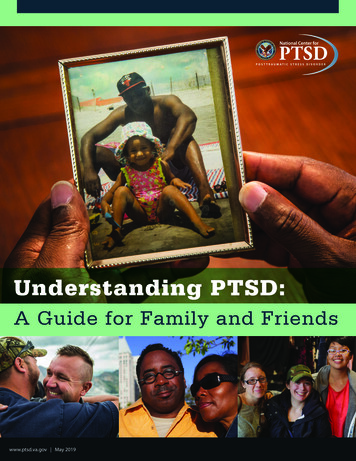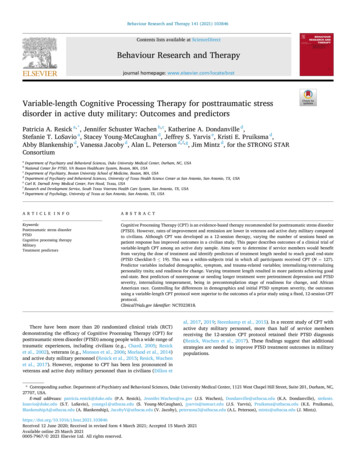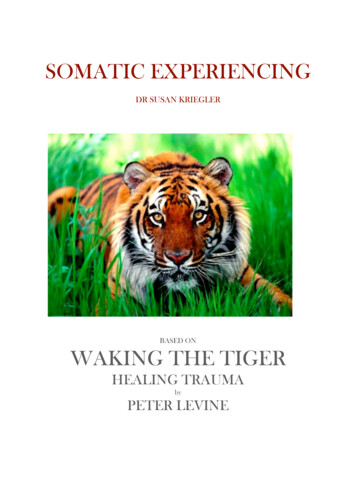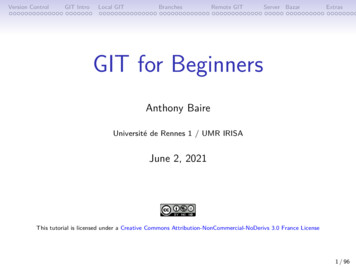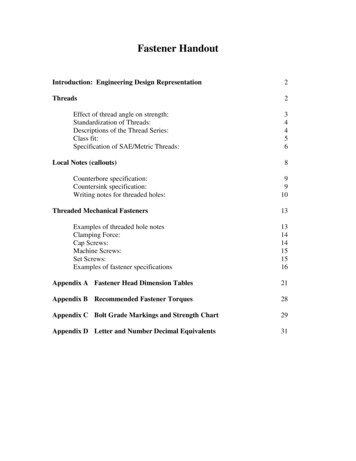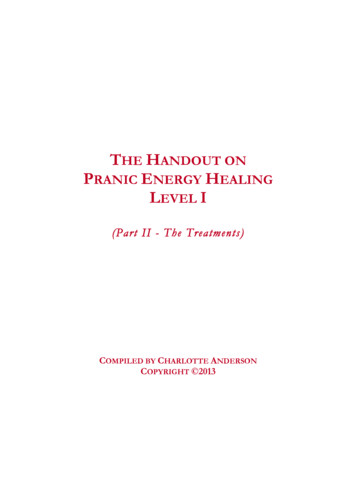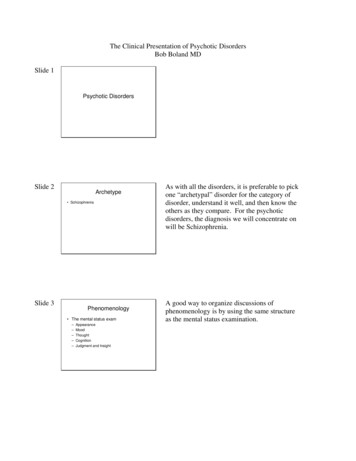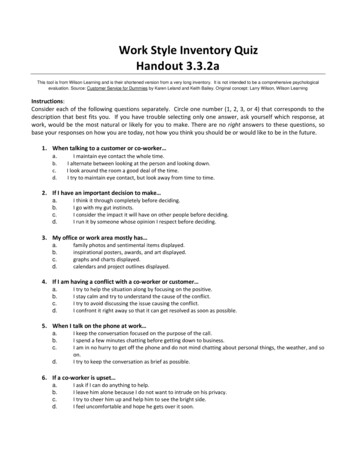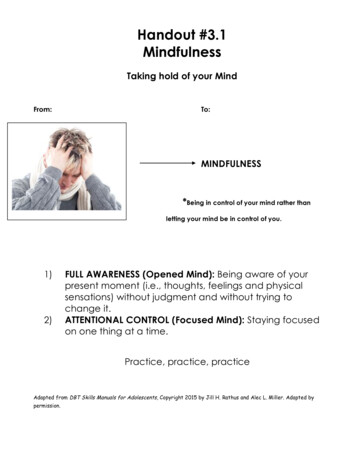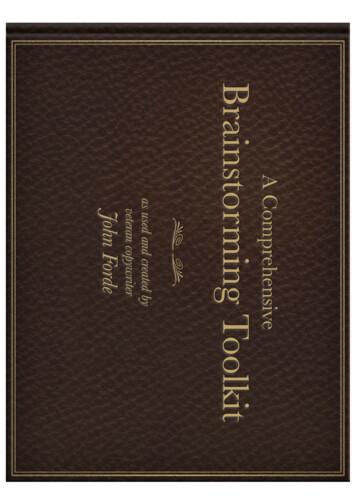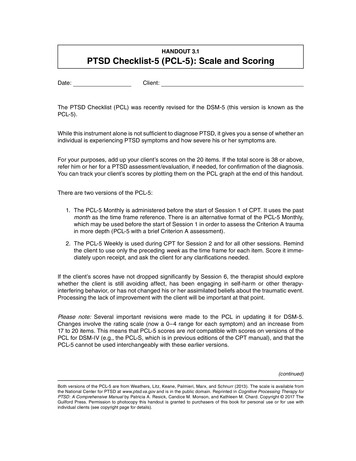
Transcription
HANDOUT 3.1PTSD Checklist-5 (PCL-5): Scale and ScoringDate:Client:The PTSD Checklist (PCL) was recently revised for the DSM-5 (this version is known as thePCL-5).While this instrument alone is not sufficient to diagnose PTSD, it gives you a sense of whether anindividual is experiencing PTSD symptoms and how severe his or her symptoms are.For your purposes, add up your client’s scores on the 20 items. If the total score is 38 or above,refer him or her for a PTSD assessment/evaluation, if needed, for confirmation of the diagnosis.You can track your client’s scores by plotting them on the PCL graph at the end of this handout.There are two versions of the PCL-5:1. The PCL-5 Monthly is administered before the start of Session 1 of CPT. It uses the pastmonth as the time frame reference. There is an alternative format of the PCL-5 Monthly,which may be used before the start of Session 1 in order to assess the Criterion A traumain more depth (PCL-5 with a brief Criterion A assessment).2. The PCL-5 Weekly is used during CPT for Session 2 and for all other sessions. Remindthe client to use only the preceding week as the time frame for each item. Score it immediately upon receipt, and ask the client for any clarifications needed.If the client’s scores have not dropped significantly by Session 6, the therapist should explorewhether the client is still avoiding affect, has been engaging in self-harm or other therapyinterfering behavior, or has not changed his or her assimilated beliefs about the traumatic event.Processing the lack of improvement with the client will be important at that point.Please note: Several important revisions were made to the PCL in updating it for DSM-5.Changes involve the rating scale (now a 0–4 range for each symptom) and an increase from17 to 20 items. This means that PCL-5 scores are not compatible with scores on versions of thePCL for DSM-IV (e.g., the PCL-S, which is in previous editions of the CPT manual), and that thePCL-5 cannot be used interchangeably with these earlier versions.(continued)Both versions of the PCL-5 are from Weathers, Litz, Keane, Palmieri, Marx, and Schnurr (2013). The scale is available fromthe National Center for PTSD at www.ptsd.va.gov and is in the public domain. Reprinted in Cognitive Processing Therapy forPTSD: A Comprehensive Manual by Patricia A. Resick, Candice M. Monson, and Kathleen M. Chard. Copyright 2017 TheGuilford Press. Permission to photocopy this handout is granted to purchasers of this book for personal use or for use withindividual clients (see copyright page for details).
HANDOUT 3.1 (p. 2 of 7)PCL-5 WITH BRIEF CRITERION A ASSESSMENT: MONTHLYInstructions: This questionnaire asks about problems you may have had after a very stressfulexperience involving actual or threatened death, serious injury, or sexual violence. It could besomething that happened to you directly, something you witnessed, or something you learnedhappened to a close family member or close friend. Some examples are a serious accident; fire;disaster such as a hurricane, tornado, or earthquake; physical or sexual attack or abuse; war;homicide; or suicide.First, please answer a few questions about your worst event, which for this questionnaire meansthe event that currently bothers you the most. This could be one of the examples above or someother very stressful experience. Also, it could be a single event (for example, a car crash) ormultiple similar events (for example, multiple stressful events in a war zone or repeated sexualabuse).Briefly identify the worst event (if you feel comfortable doing so):How long ago did it happen?Did it involve actual or threatened death, serious injury, or sexual violence? Yes NoHow did you experience it? It happened to me directly I witnessed it I learned about it happening to a close family member or close friend I was repeatedly exposed to details about it as part of my job (for example, paramedic,police, military, or other first responder) Other (please describe)If the event involved the death of a close family member or close friend, was it due to some kindof accident or violence, or was it due to natural causes? Accident or violence Natural causes Not applicable (the event did not involve the death of a close family member or closefriend)Second, keeping this worst event in mind, read each of the problems on the next page and thencircle one of the numbers to the right to indicate how much you have been bothered by thatproblem in the past month.(continued)
HANDOUT 3.1 (p. 3 of 7)PCL-5: MONTHLYInstructions: Below is a list of problems that people sometimes have in response to a very stressful experience. Please read each problem carefully, and then circle one of the numbers to theright to indicate how much you have been bothered by that problem in the past month.In the past month, how muchwere you bothered by:Not at allA little bitModerately1. Repeated, disturbing, andunwanted memories of thestressful experience?012342. Repeated, disturbingdreams of the stressfulexperience?012343. Suddenly feeling oracting as if the stressfulexperience were actuallyhappening again (as if youwere actually back therereliving it)?012344. Feeling very upset whensomething reminded you ofthe stressful experience?012345. Having strong physicalreactions when somethingreminded you of thestressful experience (forexample, heart pounding,trouble breathing,sweating)?012346. Avoiding memories,thoughts, or feelings relatedto the stressful experience?012347. Avoiding external remindersof the stressful experience(for example, people,places, conversations,activities, objects, orsituations)?012348. Trouble rememberingimportant parts of thestressful experience?01234Quite a bit Extremely(continued)
HANDOUT 3.1 (p. 4 of 7)In the past month, how muchwere you bothered by:Not at allA little bitModerately9. Having strong negativebeliefs about yourself, otherpeople, or the world (forexample, having thoughtssuch as: I am bad, thereis something seriouslywrong with me, no onecan be trusted, the world iscompletely dangerous)?0123410. Blaming yourself orsomeone else for thestressful experience or whathappened after it?0123411. Having strong negativefeelings such as fear, horror,anger, guilt, or shame?0123412. Loss of interest in activitiesthat you used to enjoy?0123413. Feeling distant or cut offfrom other people?0123414. Trouble experiencingpositive feelings (forexample, being unableto feel happiness or haveloving feelings for peopleclose to you)?0123415. Irritable behavior, angryoutbursts, or actingaggressively?0123416. Taking too many risks ordoing things that couldcause you harm?0123417. Being “superalert” orwatchful or on guard?0123418. Feeling jumpy or easilystartled?0123419. Having difficultyconcentrating?0123420. Trouble falling or stayingasleep?01234Quite a bit Extremely(continued)
HANDOUT 3.1 (p. 5 of 7)PCL-5: WEEKLYInstructions: Below is a list of problems that people sometimes have in response to a very stressful experience. Please read each problem carefully, and then circle one of the numbers to theright to indicate how much you have been bothered by that problem in the past week.In the past week, how muchwere you bothered by:Not at allA little bitModerately1. Repeated, disturbing, andunwanted memories of thestressful experience?012342. Repeated, disturbingdreams of the stressfulexperience?012343. Suddenly feeling oracting as if the stressfulexperience were actuallyhappening again (as if youwere actually back therereliving it)?012344. Feeling very upset whensomething reminded you ofthe stressful experience?012345. Having strong physicalreactions when somethingreminded you of thestressful experience (forexample, heart pounding,trouble breathing,sweating)?012346. Avoiding memories,thoughts, or feelings relatedto the stressful experience?012347. Avoiding external remindersof the stressful experience(for example, people,places, conversations,activities, objects, orsituations)?012348. Trouble rememberingimportant parts of thestressful experience?01234Quite a bit Extremely(continued)
HANDOUT 3.1 (p. 6 of 7)In the past week, how muchwere you bothered by:Not at allA little bitModerately9. Having strong negativebeliefs about yourself, otherpeople, or the world (forexample, having thoughtssuch as: I am bad, thereis something seriouslywrong with me, no onecan be trusted, the world iscompletely dangerous)?0123410. Blaming yourself orsomeone else for thestressful experience or whathappened after it?0123411. Having strong negativefeelings such as fear, horror,anger, guilt, or shame?0123412. Loss of interest in activitiesthat you used to enjoy?0123413. Feeling distant or cut offfrom other people?0123414. Trouble experiencingpositive feelings (forexample, being unableto feel happiness or haveloving feelings for peopleclose to you)?0123415. Irritable behavior, angryoutbursts, or actingaggressively?0123416. Taking too many risks ordoing things that couldcause you harm?0123417. Being “superalert” orwatchful or on guard?0123418. Feeling jumpy or easilystartled?0123419. Having difficultyconcentrating?0123420. Trouble falling or stayingasleep?01234Quite a bit Extremely(continued)
HANDOUT 3.1 (p. 7 of 7)PCL-5 SCORE SHEET8075706560PCL-5 Score555045403530252015105001234567Session #8910111213
HANDOUT 3.2Patient Health Questionnaire–9 (PHQ-9):Scale and ScoringDate:Client:Depressive symptom monitoring is optional in the CPT protocol, but it is encouraged when clients endorse depressive symptomatology. In that case, the PHQ-9 may be given every 2 weeksduring the course of CPT to monitor depressive symptoms.While this instrument alone is not sufficient to diagnose depressive disorders, it gives you asense of whether an individual is experiencing depressive symptoms and how severe his or hersymptoms are.For your purposes, add up your client’s scores on the 9 items provided below. The total scoreguidelines are as follows:TOTAL SCORE DEPRESSION SEVERITYScoreDepression severity1–4Minimal depression5–9Mild depression10–14Moderate depression15–19Moderately severe depression20–27Severe depressionThere is one additional item at the end of the measure that assesses the impact of these symptoms on functioning.Initial of Client’s Last Name:Therapist’s Initials:Format of CPT: IndividualDate: GroupSession: CPT-C CPT(continued)The PHQ-9 was developed by Drs. Robert L. Spitzer, Janet B. W. Williams, Kurt Kroenke, and colleagues, with an educationalgrant from Pfizer, Inc. No permission is required for its use. Reprinted in Cognitive Processing Therapy for PTSD: A Comprehensive Manual by Patricia A. Resick, Candice M. Monson, and Kathleen M. Chard. Copyright 2017 The Guilford Press.Permission to photocopy this handout is granted to purchasers of this book for personal use or for use with individual clients(see copyright page for details).
HANDOUT 3.2 (p. 2 of 2)PHQ-9Over the last 2 weeks, how often have you been bothered by any of the following problems?Read each item carefully, and circle your response.Not at allSeveraldaysMore thanhalf thedaysNearlyevery day1. Little interest or pleasure in doingthings01232. Feeling down, depressed, orhopeless01233. Trouble falling asleep, stayingasleep, or sleeping too much01234. Feeling tired or having little energy01235. Poor appetite or overeating01236. Feeling bad about yourself—orthat you are a failure or have letyourself or your family down01237. Trouble concentrating on things,such as reading the newspaper orwatching television01238. Moving or speaking so slowly thatother people could have noticed—or the opposite: being so fidgetyor restless that you have beenmoving around a lot more thanusual01239. Thoughts that you would be betteroff dead or thoughts of hurtingyourself in some way0123If you checked off any problems, how difficult have these problems made it for you to do yourwork, take care of things at home, or get along with other people?Not difficult at all Somewhat difficult Very difficult Extremely difficult
HANDOUT 4.1Cognitive Processing Therapyfor Posttraumatic Stress Disorder: ContractDate:Client:What is cognitive processing therapy?Cognitive processing therapy (CPT) is a cognitive-behavioral treatment for posttraumatic stressdisorder (PTSD) and related problems.What are the goals of CPT?The overall goals of CPT are to improve your PTSD symptoms, and any associated symptomsyou may have (such as depression, anxiety, guilt, or shame). It also aims to improve your dayto-day living.What will CPT in this clinic consist of?CPT in this clinic consists of 6–24 individual (one-on-one) therapy sessions; the average is 12.Each session lasts 50–60 minutes. In these sessions, you will learn about the symptoms ofPTSD and the reasons why some people develop it.You and your therapist will also identify and explore how your trauma or traumas have changedyour thoughts and beliefs, and how some of these ways of thinking may keep you “stuck” in yoursymptoms. CPT does not involve repeatedly reviewing the details of your trauma(s). However,you will be asked to examine your experiences in order to understand how they have affectedyour thoughts, feelings, and behaviors.What is expected of me in CPT?Perhaps the most important expectation of CPT is for you to make a commitment to come tosessions.In addition, after each session you will be given practice assignments to complete outside thesessions. These assignments are designed to improve your PTSD symptoms more rapidly outside the treatment sessions. You are also encouraged to ask any questions that you might haveat any point in doing CPT.(continued)From Cognitive Processing Therapy for PTSD: A Comprehensive Manual by Patricia A. Resick, Candice M. Monson, and Kathleen M. Chard. Copyright 2017 The Guilford Press. Permission to photocopy this handout is granted to purchasers of thisbook for personal use or for use with individual clients (see copyright page for details). Purchasers can download additionalcopies of this mater
PTSD Checklist-5 (PCL-5): Scale and Scoring Date: Client: The PTSD Checklist (PCL) was recently revised for the DSM-5 (this version is known as the PCL-5). While this instrument alone is not sufficient to diagnose PTSD, it gives you a sense of whether an individual is experiencing PTSD symptoms and how severe his or her symptoms are.
